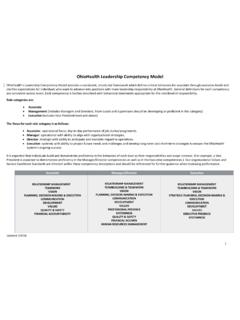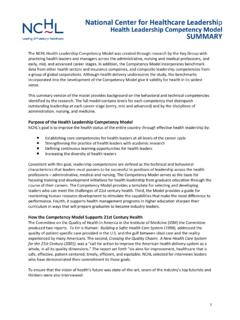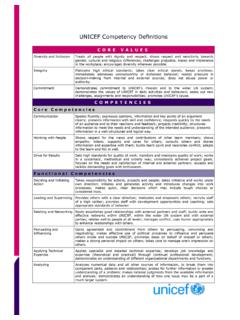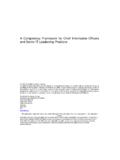Transcription of Learn to Apply and Develop the NEW #1 Workplace …
1 critical thinking Means Business: Learn to Apply and Develop the NEW #1 Workplace Skill By Judy Chartrand, , Heather Ishikawa, MA, & Scott FlanderCopyright 2013 Pearson Education, Inc. or its affiliate(s). All rights of Contents Introduction to critical thinking Means Business ..1 Too Little critical thinking = Big Problems ..2 critical thinking in the Workplace ..3 How critical thinking Works: Introduction to the RED Model ..4 Using the RED Model in Decision Making: A Case Study ..6 For Trainers - Developing critical Thinkers and Problem Solvers Using the RED Model: A Sample Training Program.
2 7 Conclusion ..8 References ..9 About Us .. | 2013 Pearson Education, Inc. or its affiliate(s). All rights thinking Means Business IntroductionWhen more than 400 senior HR professionals were asked in a survey to name the most important skill their employees will need in the next five years, critical thinking ranked the highest surpassing innovation or the application of information Such a response reflects how the nature of work and the skills required have been changing globalization and the increased speed of business, employees at every level are facing an increasingly complex flow of information.
3 Work settings are changing rapidly, and employees are moving into new roles, often with limited direction. Employees can no longer rely on others to make key decisions. They often must make them on their own, and quickly. And the decisions have to be good ones. If they fall short, there may be no time to decisions require focusing on the most relevant information, asking the right questions, and separating reliable facts from false assumptions all elements of critical thinking . And yet too few employees possess these essential skills. A survey of HR professionals conducted by the Society for Human Resource Management (SHRM) and The Conference Board found that a full 70 percent of employees with a high school education were deficient in critical thinking skills.
4 Even among employees with a four-year college education, 9 percent were deficient in critical thinking skills, 63 percent had adequate skills, and only 28 percent were rated excellent critical business leaders also come up short. Senior executive-development professionals report that the competency that next-generation leaders lack the most is strategic thinking , which hinges on critical thinking Many next-generation leaders also lack the ability to create a vision or to understand the total enterprise and how the parts work together both competencies that are closely tied to critical can be done?
5 Once organizations understand the role of critical thinking in everyday decision making, they can begin to take steps to Develop that skill in their leaders and employees. This paper describes some possible solutions, including a model for understanding and developing critical thinking . It also provides trainers with some specific techniques that can jump-start the executive-development professionals report that the competency that next-generation leaders lack the most is strategic thinking , which hinges on critical thinking | 2013 Pearson Education, Inc. or its affiliate(s). All rights Little critical thinking = Big ProblemsThe Department of Labor has identified critical thinking as the raw material of a number of key Workplace skills, such as problem solving, decision making, organizational planning, and risk management.
6 There is no lack of examples of what happens when an absence of critical thinking in business cascades into a complete systems 2007, Circuit City fired 3,400 of its highest paid store employees, saying it needed to make the cuts to remain competitive with Best Buy and other electronics retailers. The employees, the company said in a statement, had previously been given raises by managers that paid them above the market-based salary range for their role, and would be replaced by workers making less money. The move resulted in a storm of public reaction. News stories quoted angry consumers who vowed to boycott Circuit City for what they considered shabby treatment of successful employees.
7 Sales of big-ticket items such as flat-panel televisions dropped off suddenly and sharply, forcing the company to revise its revenue estimates downward. Industry analysts blamed the poor sales on the job cuts, saying that when consumers buy expensive, complicated electronics, they expect the sales staff to be experienced and knowledgeable. Shoppers likely were reluctant to take a chance at Circuit City, the analysts The company downplayed the possibility that reduced sales were related to the firings, saying that only two or three salespeople per store, on average, were it is impossible to know exactly what went on in Circuit City s executive offices, it is clear the company miscalculated on several fronts.
8 It failed to fully consider what the public reaction might be, not only to the firings, but to the lack of experienced staff on the sales floor. It seemed the company was so focused on the bottom line, it failed to look at the larger picture. These are signs of a breakdown in critical thinking . A window into the company s thought process can be found in its suggestion that because few employees per store were fired, the drop in sales of expensive items was probably not related. But how many would-be shoppers did encounter inexperienced sales staff, and walked out emptyhanded? And how many more simply stayed away from Circuit City altogether because they had seen the news reports, and did not expect to find knowledgeable employees?
9 Public perception no doubt played an important role in the entire affair, something the company even in the face of disaster apparently failed to comprehend. The firings may even have contributed to the company s eventual demise. Circuit City continued to lose ground in the electronics wars and could not survive the recession. The chain liquidated all of its stores in 2008 and 2009. | 2013 Pearson Education, Inc. or its affiliate(s). All rights failure in critical thinking may have also sabotaged an ambitious plan by UK-based Tesco, the world s third-largest retailer, to blanket the West Coast of the with a chain of small grocery stores focusing on fresh foods.
10 Prior to opening its first Fresh & Easy stores, Tesco conducted an extraordinary level of market research, with Tesco executives living in the homes of American consumers to observe their eating and shopping habits. However, the Fresh & Easy concept failed to catch fire, and expansion plans for the chain were scaled back. Tim Mason, the head of Tesco s business, said that despite the intensive market research, the company failed to realize that Americans would not be content with Fresh & Easy s everyday-low-prices strategy, and wanted to see coupons and other special offers. A comment Mason made later to The Times of London was particularly revealing of the company s thought process.







